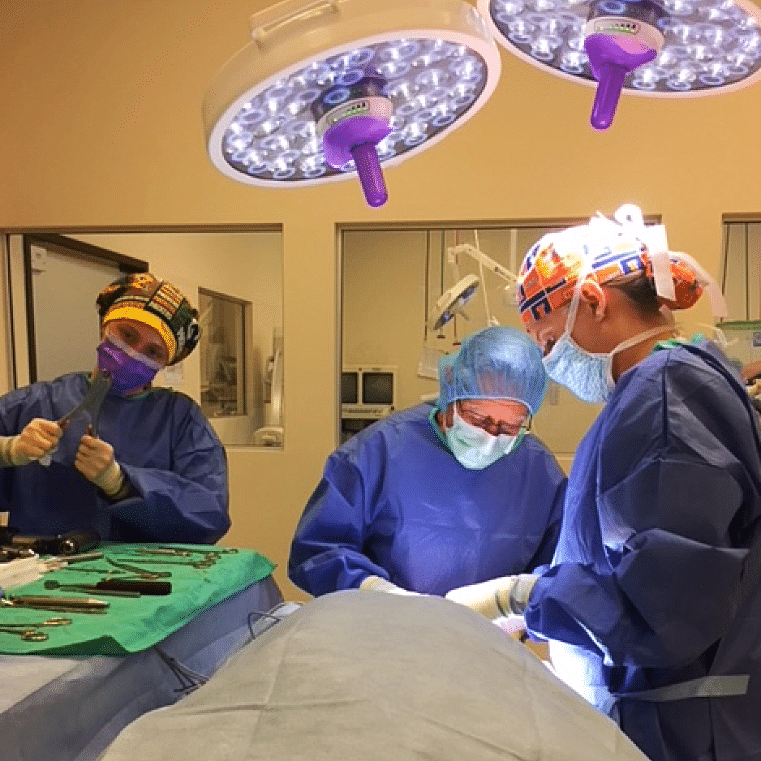
Total hip replacement (THR) is considered the gold standard treatment for large-breed dogs affected by severe hip dysplasia, especially when medical management has become ineffective. Our orthopedic team at Austin Veterinary Emergency and Specialty Center (AVES) has the ability to perform this technically demanding procedure to improve your pet’s quality of life.
What is total hip replacement in dogs?
THR involves removing your dog’s femoral head and acetabulum (i.e., the ball and socket), and replacing them with metal and polyethylene implants. The prostheses come in several sizes, and the size needed can typically be determined by evaluating the dog’s X-rays. Different methods are used to fix these components in place, depending on the individual patient. THR’s goal is to restore normal function to the hip joint, and alleviate the pain and discomfort associated with hip dysplasia.
What dogs are candidates for total hip replacement?
THR indications include arthritis secondary to hip dysplasia, arthritis secondary to acetabular or femoral fractures, primary treatment for femoral head fractures, and recurrent hip luxation. The typical candidate is a middle-aged to older dog who has increasing hip pain. Signs usually include a reluctance to walk and jump, difficulty walking up stairs, and generalized stiffness that is exacerbated by exercise. Young dogs who are not candidates for optional surgical procedures, such as juvenile pubic symphysiodesis and triple pelvic osteotomy, also are candidates. Signs in these dogs include bunny hopping, a wobbly gait, reluctance to walk and jump, less playful behavior, and aggression toward other dogs. Other criteria your dog must meet to be considered a THR candidate include:
- Hip pain — Your dog should be clinically lame because of hip pain that is unresponsive to conservative management. The decision to perform THR should not be determined based only on your dog’s X-rays.
- Size — Your dog must be large enough to accommodate the smallest prosthesis. Total hips can usually be placed in dogs weighing 40 pounds or more.
- Age — Your dog must be skeletally mature, which generally occurs by 9 to 12 months of age. Some giant-breed dogs may need longer to finish growing.
- Health — Your dog must be in good general health, with no other signs that indicate issues, such as degenerative nerve or muscle disorders. They also should not have a known bacterial source, such as periodontal disease.
The ideal TRH candidate has one affected hip and one normal hip. However, the majority of dogs are affected in both hips, although one hip is typically worse clinically. Usually, these dogs’ quality of life can be significantly improved by replacing only the more damaged hip. Only about 20 percent of dogs require both hips replaced, and the decision to operate on the second side is typically made after recovery from the first procedure.
What are the alternative options to total hip replacement for dogs?
Depending on your dog’s age and condition, alternatives may be available to manage your dog’s hip issues.
- Medical management — This approach is typically used in middle-aged to older dogs who live a relatively sedentary lifestyle, and involves maintaining your dog at a minimal body weight, limiting their exercise routine, daily or intermittent non-steroidal anti-inflammatory drug (NSAID) administration, cartilage protective supplements, and physical therapy.
- Juvenile pubic symphysiodesis — This procedure can be performed in puppies 10 to 18 weeks old who have pathological joint laxity that could result in hip dysplasia. This minimally invasive surgery closes the growth plate at the bottom of the pelvis, so the femoral head becomes increasingly covered by the acetabulum as the puppy grows during the following four to six months.
- Double or triple pelvic osteotomy — This procedure is another option for immature dogs younger than 8 to 10 months, who have hip dysplasia but no visible arthritic changes on X-ray. This technique involves cutting the pelvic bone in two or three places and rotating the segments, to improve femoral head coverage by the acetabulum and decrease hip laxity.
- Femoral head ostectomy — This procedure can be performed on dogs of any age who weigh less than 60 pounds, to provide enough comfort to avoid daily NSAID use. This technique involves removing the femoral head to relieve pain caused by hip dysplasia, but normal hip function is not maintained.

What is the postoperative care for dogs after a total hip replacement?
Hospitalization for dogs following a THR is typically three to five days. Your dog’s incision will need close monitoring for infection signs, such as redness, swelling, and discharge, and special collars are sometimes needed to discourage dogs from biting or licking their incisions. At discharge, you will receive detailed postoperative care instructions that outline strict activity restrictions for three months after surgery.
- First month — For the first month after surgery, your dog should be confined to a small area, such as a crate. They can be taken for controlled leash walks to relieve themselves, but must then be immediately returned to their crate. Inside the house, your dog should not be allowed on stairs or slippery floors. Their sutures will be removed 10 to 14 days after surgery.
- Second month — After the first month, slow five-minute leash walks can begin two to three times a day. These walks can be increased by about five minutes each week.
- Third month — Walks and physical therapy are continued for an additional month, and a recheck examination performed to determine if your dog is ready to return to normal activity. Most dogs reach this goal in about three to four months.
TRH has extremely high success rates, and is an excellent option for many dogs suffering from hip disease. If your dog could benefit from a TRH, contact our team at AVES to schedule an appointment, so we can get them running and jumping again.
- Gastrointestinal Foreign Body by Jeremy Fleming, DVM, DACVS-SA - March 24, 2025
- Angular Limb Deformity by Russell Kalis, DVM, DACVS-SA - November 18, 2024
- Caustic Substance Injury by Jami Becker, DVM, DACVECC - September 30, 2024

